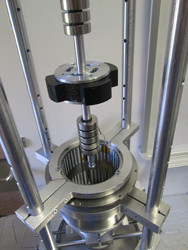Contactless transmission gear
Power transmission systems are, as their name suggests, devices used to transmit power or forces. Gears are elements of mechanical power transmission systems. These toothed wheels can alter the speed of driven parts (for example, the wheels of a car) relative to the speed of their driving mechanism (in the case of a car, its engine). EU-funded researchers have developed a new transmission gear system based on magnetic forces that prevent friction and wear; and with no touching parts, it makes lubrication unnecessary. They substituted the gear teeth with magnets that repel and attract each other so that the transmission of forces between moving parts is achieved without contact. This breakthrough technology is the result of the EU-funded 'Magnetic-superconductor cryogenic non-contact harmonic drive' (MAGDRIVE) project. The development of the new transmission gear system entailed the design of magnetic gear reducer and corresponding frictionless magnetic input and output axles. Specifically, it has levitating superconductor bearings that generate stable attraction and repulsion forces into the system's structure. These allow the axles to float and ensure stability by mitigating oscillatory movements and possible imbalances. With both the input and output axles floating without any contact, they can keep spinning at up to 3 000 revolutions per minute. To demonstrate the applications for contactless transmission, MAGDRIVE researchers created two prototypes. The first was designed for space travel and planetary exploration missions, and is a cryogenic model that keeps axles floating at temperatures as low as –210 degrees Celsius in vacuum. The second prototype may be used in machinery for rail, oil and aircraft industries. Presented at conferences organised by the European Space Agency (ESA), the National Aeronautics and Space Administration (NASA), and the American Society of Mechanical Engineers (ASME), project results have been published in the Journal of Engineering Tribology. The spin-off company MAG SOAR has been created to explore commercial exploitation of the technology developed during MAGDRIVE.
Keywords
Transmission gear system, power transmission, magnetic forces, superconductor, harmonic drive







